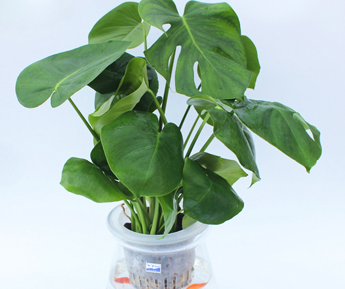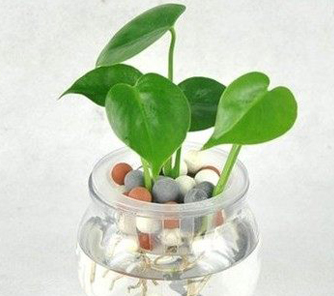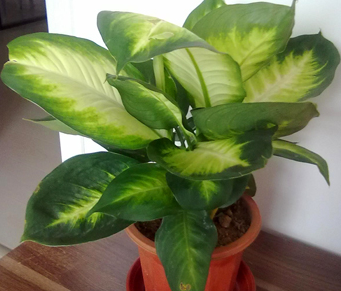Can the tortoise-backed bamboo be hydroponically cultured? how to control diseases and insect pests
To talk about this turtle shell bamboo can be hydroponic, this is everyone knows, and rich bamboo cultivation method is the same, to see if the turtle shell bamboo can be hydroponic after cutting it? How to prevent pests:

Can you cut off the turtle bamboo after hydroponics:
Turtle bamboo itself is propagated by cuttings, so the broken stems are completely suitable for hydroponics. However, because the broken stem may be subject to other damage, and without roots, it must wait for new roots to better absorb water and nutrients, therefore, it is very susceptible to bacterial infection in the process of hydroponic culture, there is rot, so hydroponic may wish to use potassium permanganate diluent before a little disinfection. When hydroponics, shade facilities should be made to ensure certain light but avoid direct sunlight. It is also necessary to spray water on leaves frequently. When it grows roots, it is really alive. At this time, it can resume normal watering, fertilization and other nursing measures.
How to prevent pests:
1. Grey spot disease
Symptoms: The disease starts from the leaf margin. At first, there are small brown spots on the surface of the leaves. Then the spots gradually become larger and become round or irregular black brown spots. Lesions can connect to each other and eventually cause the leaves to die.
Control methods: first, improve indoor environmental conditions, strengthen cultivation management. Pay attention to control indoor temperature, if the temperature is too high, water to cool down, if the temperature is too low, add cold cover; also pay attention to reasonable fertilization and watering, timely control pests. Once found on the leaves have disease spots, to remove in time, and the disease leaves destroyed. Second, chemical control. Bordeaux mixture was sprayed in the early stage of the disease, and Tuijunte was sprayed in the late stage. Finally, clean your home. The home environment is clean and tidy, and diseases and insect pests are not easy to breed.
2. Rust
Symptoms: At the beginning of the disease, yellow spots appear on the leaves. The spots are the size of needle tips, and then they connect with each other and become large spots. Severe, the leaves are full of spots, yellow off.
Prevention and control methods: firstly, avoid spraying watering to reduce the spread of germs; secondly, the bottom of the flowerpot planted with turtleback bamboo should not be sealed and the flowerpot should be separated from the flowerpot for a certain distance; thirdly, ventilation and moisture removal should be carried out to reduce the permeability between plants; finally, chemical control should be carried out, and triadimefon wettable powder or chlorothalonil and thiophane wettable powder should be sprayed at the early stage of disease.
Even after cutting off the turtle, it can also be cultured, and it can still survive. Raising the turtle is also to pay attention to pests and diseases.
The methods of obtaining and transforming hydroponic plants 1. The methods of obtaining hydroponic plants can be obtained by direct and indirect methods. 1 Direct harvesting Direct harvesting refers to a method of converting soil-cultured plants directly into hydroponic materials. According to different plant morphology, we can adopt corresponding methods to obtain hydroponic materials. (1) Single plant type Soil-cultured plants matching the container size are dug up whole as hydroponic materials. (2) Digging out the whole plant from the soil or pot, shaking off the soil, exposing the joint part between the daughter plant and the mother plant, and cutting it from the joint with a sharp blade; selecting the daughter plant with root system, healthy and harmless from diseases and pests as the hydroponic material. Factor plants have cuts, should first use plant ash or charcoal powder or fine bran ash daub on the cut, wait for the cut to dry before conversion. This kind of plant has white crane taro, evergreen, tiger tail orchid, syncarp taro, drought umbrella grass, palm bamboo and so on. (3) For plants with vine seedlings, dig out the root shoots sprouted from the rhizosphere of the soil culture mother plant, cut out the root shoots with suitable size, strong growth, no diseases and insect pests and root system with sharp edges, and treat the incisions as hydroponic materials. Such as Clivia, aloe, pineapple, agave, tiger tail orchid, etc.(4) plants with walking stems are slender stems on the ground, and one or more seedlings can often grow on the stems. Cut the seedlings, protect the roots, and use them as hydroponic materials. Such as gold heart hanging orchid. (5) The plants with seed balls are used as hydroponic materials by stripping the healthy seed balls from the soil culture mother balls. Such as cactus, etc. 2 Indirect harvesting refers to using seedlings obtained by seed propagation and tissue culture as hydroponic material. Two, hydroponic method 1 root washing method According to the hydroponic plant raw materials have no root system, different conversion methods can be used to wash roots, root washing method is suitable for hydroponic plant raw materials with roots. Root washing is best in late spring and early autumn, because the temperature in this season is generally about 20℃, which is the appropriate temperature for plant growth and conducive to germination of water bacon; at the same time, the oxygen content in water in late spring and early autumn is higher, so that the respiration of roots is guaranteed. Therefore, late spring and early autumn are the best time for plant soil culture to be converted to plant hydroponic culture. The specific methods of root washing are as follows: 1) Remove soil and root washing After digging out the raw materials of soil culture plants with roots, remove the heavy soil on the roots, and then wash them with clean water. Take care there is no soil residue. For plants with sparse roots, it is not advisable to cut them, otherwise it will affect the adaptability of conversion to hydroponic culture. 2) Place them in a shady place and keep the air moist. Place the plants maintained by clear water in a shady place and do not receive direct sunlight. When the air is dry, spray them to the leaves and the surroundings to keep the air moist. 3) Change water frequently In the process of conversion and adaptation, the clean water contained in it should be changed frequently. Changing clean water can not only ensure clean water quality, reduce the harm of bacteria to root wounds, but also increase the oxygen content in water. Frequency of water change depends on plant species. (1) Water insertion method Water insertion method is applicable to raw materials of hydroponic plants without roots. It refers to the method of cutting a stem or branch from the mother plant and inserting the stem into the water to take root, thus forming a new hydroponic plant. Water insertion method is divided into two categories according to the different structure of raw materials. 1, general plants (non-meat plants) water insertion method should be carried out in late spring and early autumn, because the temperature at this time is suitable for root development, while the oxygen content in the water can also meet the respiratory metabolism of the root system. When carrying out water insertion, attention should be paid to several points: 1. Plant selection: stems and branches are cut from plants that can quickly take root in water as raw materials for hydroponic cultivation, such as turtleback bamboo, ivy, ivy green, silver leaf chrysanthemum, camellia, commelina, etc. 2. Branch selection: It is advisable to select stout branches without pests and diseases. Strong branches, containing more nutrients, conducive to the formation of healing tissue and rooting. Cut branches should be from the trunk, the top and middle of the main branch, or close to the trunk, the main branch branches, because the part of the germination of roots strong ability 3, cut branches short: generally to plant species and decorative requirements. Plants with slender plant shapes can be cut longer for decoration; conversely, they can be cut shorter. In order to facilitate the combination configuration, branches can be cut into different lengths, so that the layers are rich and the plant shape is full. 4. Truncation position: 0.2~0.5 cm below the knot
- Prev

Can hydroponic turtles with bamboo on their backs raise fish? can they be cultivated in soil?
If you want to talk about this tortoise-backed bamboo, it is relatively easy to raise, or it can be hydroponically cultivated. Let's take a look at whether hydroponic turtle-backed bamboo can raise fish. Can hydroponic turtle back bamboo be cultivated in soil? can hydroponic tortoise back bamboo cultivate fish? generally speaking, hydroponic turtle back bamboo can also raise fish. Grasp the principle of flower cultivation, fish culture as a supplement, and small fish culture as the best.
- Next

Is evergreen poisonous? can it be raised by water?
To talk about this evergreen, this is what many people like to breed. As long as evergreen is cultured, it will be like this all the year round. Let's see if evergreen is poisonous. Can evergreen be raised in water? is evergreen poisonous? evergreen has some toxicity, but it is the same as most potted plants.
Related
- Fuxing push coffee new agricultural production and marketing class: lack of small-scale processing plants
- Jujube rice field leisure farm deep ploughing Yilan for five years to create a space for organic food and play
- Nongyu Farm-A trial of organic papaya for brave women with advanced technology
- Four points for attention in the prevention and control of diseases and insect pests of edible fungi
- How to add nutrient solution to Edible Fungi
- Is there any good way to control edible fungus mites?
- Open Inoculation Technology of Edible Fungi
- Is there any clever way to use fertilizer for edible fungus in winter?
- What agents are used to kill the pathogens of edible fungi in the mushroom shed?
- Rapid drying of Edible Fungi

